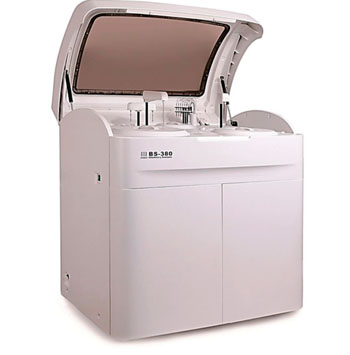Novel Turbidimetric Immunoassay Evaluated for Fecal Calprotectin
By LabMedica International staff writers
Posted on 28 Sep 2016
Calprotectin is a multifunctional protein that plays an important role in the diagnosis and follow-up of inflammatory bowel disease and high levels of calprotectin in stool samples are associated with inflammation of the intestinal tract.Posted on 28 Sep 2016
Fecal calprotectin assays are widely used to exclude inflammatory bowel disease (IBD) in patients with suspected IBD, but the problem with most of the fecal calprotectin assays is the rather long test-turnaround times, before the results are available to the physician.

Image: The BS-380 automatic biochemistry analyzer (Photo courtesy of Mindray).
Scientists at Uppsala University (Sweden) optimized a particle enhanced turbidimetric immunoassay (PETIA) for fecal calprotectin and validated the assay for two clinical autoanalyzers using routine fecal samples. They compared the PETIA with a commercial enzyme-linked immunosorbent assay (ELISA), known as the Bühlmann fCAL ELISA (Bühlmann Laboratories, Schönenbuch, Switzerland). This new latex based turbidimetric calprotectin assay applies particles coated with anti-human calprotectin (MRP8/14) antibodies: the agglutination is proportional to the calprotectin concentration.
The fecal calprotectin PETIA was validated on two chemistry analyzers, the Mindray BS-380 (Mindray, Shenzhen, China) and the Cobas 501 (Roche Diagnostics, Basel, Switzerland). The assay is linear in the range 11 μg/g to 2,000 μg/g, with a limit of quantitation of approximately 10 μg/g. No antigen excess hook effect was observed up to 10,000 μg/g to 15,000 μg/g depending on the instrument used. The turbidimetric method showed a good agreement with the Bühlmann ELISA. The total coefficient of variation was 3% to 8% in the 50 μg/g to100 μg/g range.
The authors concluded that the fecal calprotectin PETIA, fCal Turbo, is well suited for rapid analysis of fecal calprotectin on Mindray BS-380 or Cobas 501 clinical chemistry analyzers. The test results are concordant with the Bühlmann fecal MRP8/14 ELISA. The study was published in the September 2016 issue of the Journal of Clinical Laboratory Analysis.
Related Links:
Uppsala University
Bühlmann Laboratories
Mindray
Roche Diagnostics














